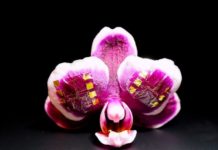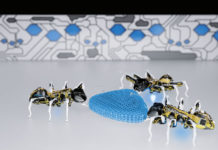Article written by Josh Perry.
Engineers are always looking for an edge in their designs to extract as much power and performance as possible from a system, while attempting to meet industry trends in miniaturization. In the power electronics industry, this has required an examination of the materials being used to overcome inherent limitations from heat, voltage, or switching speed.
 Engineers are using wide-bandgap materials to expand the capabilities of power electronics, pushing them beyond the thermal and electrical limits of silicon-based components.(Background image created by Xb100 – Freepik.com)
Engineers are using wide-bandgap materials to expand the capabilities of power electronics, pushing them beyond the thermal and electrical limits of silicon-based components.(Background image created by Xb100 – Freepik.com)For years, silicon was the answer for the power electronics market, but in the past decade there has been a growing movement towards wide-bandgap materials, particularly silicon carbide (SiC) and gallium nitride (GaN). Wide-bandgap materials have higher breakdown voltage and perform more efficiently at high temperatures than silicon-based components. [1] Recent research indicated, “For commercial applications above 400 volts, SiC stands out as a viable near-term commercial opportunity especially for single-chip current ratings in excess of 20 amps.” [2] This efficiency allows systems to consume less power, charge faster, and convert energy at a higher rate.
A recent article from Electronic Design explained that SiC power devices “operate at higher switching speeds and higher temperatures with lower losses than conventional silicon.” SiC has an internal resistance that is 100 times lower than silicon and a breakdown electric field of 2.8 MV/cm, which is far higher than silicon’s 0.3 MV/cm, meaning that SiC components can handle the same level of current in smaller packages. [3]
Engineers use the new material to produce systems with higher power-density and energy efficiency. While some industries have adopted new materials quicker than others, recent research from Yole Développement, a semiconductor and advanced packaging company based in France, indicated that there has been a significant growth in the SiC market in recent years. The research placed the market at $200 million as of 2015 and said that the market would reach an inflection point in 2017. [4]
New Electronics wrote that silicon carbide technology had reached a “tipping point” where engineers would focus more attention on new materials than on silicon, “pushed by the space, weight and efficiency requirements of electric vehicles and hybrids and by some particular industrial applications.” [5] All About Circuits added, based on the Yole research, that SiC was the material of choice for “power factor correction (PFC) power supplies, chargers, photovoltaic inverters, and trains.” [6]
As evidence of the industry’s acceptance of wide-bandgap materials, JEDEC Solid State Technology Association, a leader in standards development for the microelectronics industry, announced in September that it formed a committee on Wide Bandgap Power Electronic Conversion Semiconductors with sub-committees for SiC and GaN. “GaN and SiC technologies are poised to benefit from the development of standards focused on quality and reliability, datasheets, and test methods,” said Tim McDonald, Senior Director, GaN Applications and Marketing at Infineon Technologies. [7]
Industry leaders such as Texas Instruments (TI), Infineon, and Wolfspeed have signed on to the JEDEC committee and have already established products based on SiC technology. For instance, Infineon has released CoolSiC™ semiconductor solutions that include MOSFET, Schittky diodes, and hybrid modules. [8] ROHM Semiconductor recently announced that it had produced full SiC power modules that it claims reduces switching losses by 64 percent at 150°C. The company also announced that it is supplying power modules for the Venturi Formula E racing team. [9]
At the recent APEC 2018 show in San Antonio, sponsored by the PSMA (Power Sources Manufacturers Association), TI unveiled a new reference design (pictured below) for an HEV/EV onboard charger that used SiC-isolated gate drivers. [10]
 ATS cold plates were on display at the TI booth, as a thermal solution for a new TI design. (Advanced Thermal Solutions, Inc.)
ATS cold plates were on display at the TI booth, as a thermal solution for a new TI design. (Advanced Thermal Solutions, Inc.)Thermal Management Concerns for SiC
SiC (and GaN) is clearly not just the future of semiconductor technology, it is also the present, but while wide-bandgap material allows components to perform at higher temperatures, there are thermal management concerns that engineers need to consider when designing the devices into a system. While SiC and other wide-bandgap materials may be able to withstand high temperatures, there are potential performance issues, such as higher rates of switching losses, and researchers still recommend that SiC dies operate at temperatures lower than 100°C for best efficiency. [11]
Higher temperature limits mean that, in theory, less complex cooling systems are required, which also means that SiC component packaging can be smaller since it no longer needs to account for larger, more intricate thermal management designs. It also means potential cost- and energy-savings for designers. But, the higher heat loads and the desire for smaller packaging mean passive, air cooling techniques are unlikely to accommodate the thermal management needs of the system. Liquid cooling is usually required, particularly the use of liquid cold plates to increase the rate of heat transfer to the ambient.
A recent presentation by SatCon Applied Technology showed that, despite higher power outputs, SiC components required smaller thermal contact areas and suggests the use of cold plates (copper in this particular example) to achieve the necessary cooling. [12] This was backed up by research from the European Research Council, which reported that active thermal management systems improved the performance of power electronics systems. [13]
Research from Cal Tech and the Jet Propulsion Laboratory (Pasadena, Calif.) explored the use of novel thermoelectric (TEC) microcoolers at the device level that provided spot cooling at higher heat fluxes than standard passive heat sinks. [14] According to researchers, the use of diamond or aluminum substrates enhanced the thermal performance of the microcoolers and thick-film coolers were able to achieve power densities greater than 100 W/cm2.
As noted in a research report by the National Renewable Energy Lab, while wide-bandgap materials can withstand much higher junction temperatures, those high heat loads can have a detrimental effect on other components in a system. Increasing the temperature of the system as a whole can lead to more failures, switching losses, and other issues for components that are not built to withstand high-temperature operation. Therefore, cooling needs to take not only a device-level but also system-level outlook. [15]
The NREL research suggested the following tactics for cooling SiC: using thermal interface material (TIM) that has low thermal resistance and is “reliable at functional temperatures,” using microchannels in cold plates to lower device junction temperatures, enhancing the surface and including “turbulence promoters” in the module, and incorporating both advanced manufacturing techniques and “multiple mode cooling” at the system level.
 This slide from the presentation by the NREL explains how thermal management of wide-bandgap materials encompassed device-level, module-level, and system-level solutions. (NREL)
This slide from the presentation by the NREL explains how thermal management of wide-bandgap materials encompassed device-level, module-level, and system-level solutions. (NREL)SiC has found a niche in the automotive world where the material is frequently mentioned in reports of new designs for electric vehicle batteries, as well as brake components and other components in high-heat environments. Some recent studies have gone beyond standard liquid cooling to include jet impingement cooling, which demonstrated significant thermal enhancement. According to a 2015 study, simulations demonstrated that a commercial, off-the-shelf (COTS) cold plate reduced the junction temperature of an SiC power module operating at a design heat load of 151 W from 290°C to 215°C. A COTS microchannel heat exchanger reduced the junction temperature to 215°C and a jet impingement-cooled heat exchanger lowered the junction temperature to 169°C at the same flow rate. [16]
The European Commission’s Community Research and Development Information Service (CORDIS) recently closed its SMARTPOWER project that brought together 15 partners from seven countries to examine the use of SiC and GaN technologies in industrial power devices. [17] The research led to the creation of forced cooling solutions with TEC modules to enhance heat sink thermal performance by as much as 200%, dropping device junction temperature from 250°C to 125°C. The research also developed enhanced TIM composed of vertically-aligned carbon nanotubes that increased heat transfer away from the devices, as part of novel 3-D packaging solutions.
Advanced Thermal Solutions, Inc. (ATS) continues to work on thermal solutions to meet the latest developments in power electronics. ATS recently released a new line of high-performance liquid cold plates that provide 30% improved performance compared to other commercially-available cold plates. An innovative, internal fin array with an optimized aspect ratio makes ATS cold plates, available in aluminum or copper and easily customizable to meet specific size or thermal requirements, the perfect choice for cooling high-powered electronics, including wide-bandgap devices.
 ATS cold plates are the perfect solution for cooling high-powered electronics, such as IGBT modules. (Advanced Thermal Solutions, Inc.)
ATS cold plates are the perfect solution for cooling high-powered electronics, such as IGBT modules. (Advanced Thermal Solutions, Inc.)ATS cold plates provide uniform surface temperature across an IGBT or other high-powered device and can be fitted to a variety of components including Semikron SemiTRANS® Case D56, Infineon 62 mm, Fuji Semiconductor M127, M234, and M235, Powerex 62 mm, Mitsubishi 62 mm, and Vincotech 62 mm packages among many others.
As wide-bandgap materials proliferate across the power industry, ATS has liquid cooling solutions that will ensure optimal thermal management. For example, the TI reference design mentioned above used a customized ATS cold plate to provide the necessary cooling.
Source: https://www.qats.com



































